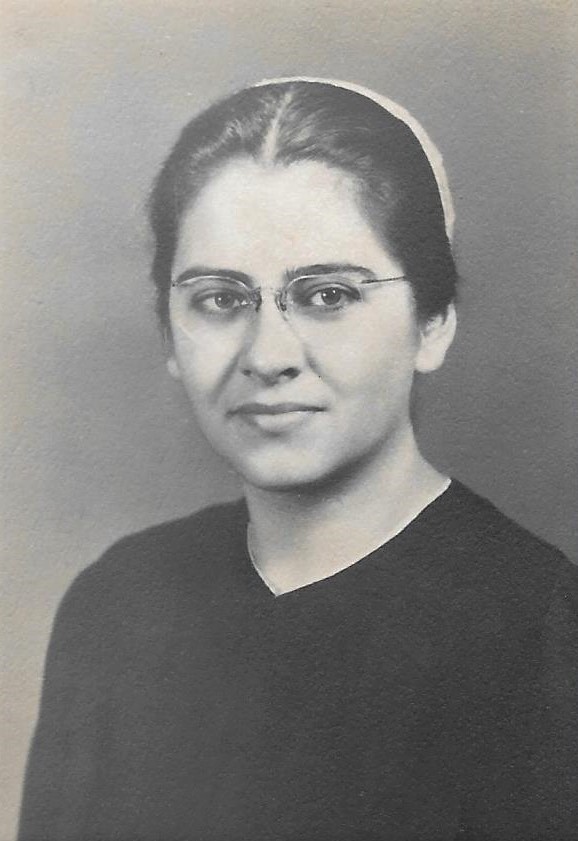Watching Aunt Esther

Many mornings I watched Aunt Esther dress. Her bedroom was across the hall from our upstairs living room. I’d go and sit on her bed waiting for her to come from the bathroom in her housecoat. Her dressing ritual was unvarying. She always began with her girdle, the literal foundation of her clothing. It held her within the confines she allowed herself, and like a machine designed by Dr. Seuss it did almost everything—cupped her generous breasts, bolstered her midsection, and fastened the tops of her long, dark nylon hose. She had to tug the girdle into place, edging the zipper up as she enclosed her soft body within its stays. Once done, she stood straight and firm.
To put on her nylon hose, she sat on her bed beside me, and gave this process meticulous attention. First, she balled her right hand into a fist and ran it to the toe of one stocking. Then, spreading her fingers, she slowly pulled her hand back out, turning it first one way and then the other to make sure there were no runners in it. Wearing a stocking with a runner was like having spinach stuck in her teeth. All day people would have whispered to her, “Do you know you have a runner,” and if she discovered one later in the day, she would have wondered who had noticed the run but had been too polite to point it out. When she was assured that the stocking was in good condition, she put it on, carefully pulling it up to make sure the seam in the back ran straight up the middle of her leg. If it tended to one side she started over, using both hands to center it. A crooked seam was as much a problem as a runner and a call for more furtive whispers or chagrinned speculations about who had noticed.
Next came her slip, as much required as a girdle, to cover her undergarments and provide more body to the skirt of her dress. Then it was time to comb her hair. She sat down on her little blue-upholstered vanity stool and unbraided her nighttime pigtail. She brushed her nearly waist-length hair, parted it carefully and pulled it back tightly, twisting it into a bun at the back of her neck. She bent her head so the bun will stay in place while she cupped a thick hairnet on the fingers of both hands and deftly fit it over the bun anchoring the whole arrangement with sturdy hair pins. She pulled her hair so tight I was sure it must hurt her, and bobby pinned in place the little curly tendrils that escaped her bun.
When every hair was tightly secured, she applied deodorant from a roll-on bottle and dusted herself generously from the pink tin of Cashmere Bouquet powder—under her arms, the outsides of her arms, down between her breasts. She created a shower of powder whose weekly accumulation I would dust up and shake from her dresser scarf on Saturday morning for the princely sum of five cents. Her second line of defense against perspiration was dress shields, a pair of half circle pads and straps that fit under her arms to protect the underarm area of her dress from getting soiled when she sweated.
Finally, it was time to put on her dress, a two-part process. She pulled the plain, long-sleeved dress over her head. Then came her cape, actually considered part of the dress, but separate. It was made of the same fabric as the dress and had a front and back that came to her waist with a belt that snapped at her side. Neither dress nor cape had a collar. A well-made cape fit smoothly over the dress, so that it would be hard at a first glance to notice it as a separate piece. She pinned down any hairs brushed out of place in the dressing process, combing them back into submission and finally put on her white net covering. It too fit exactly and covered most of her hair.

I felt satisfaction as I watched Aunt Esther. Everything fit exactly—straight lines and full, rounded curves, over her rounded body, so different from my own skinny, boney arms and legs. Each piece settled securely into place. It gave me a sense of contentment, rightness, and order. Although she was precise in dressing and combing, she was not able to contain her buoyant spirit. It spilled out as she “whistled” her way down the stairs, the word whistling in quotes because she never learned to whistle. Instead, she blew air out her mouth in a toneless “wheeo, wheeo, wheeo.” She was ready for a new day.
Note: From a chapter that didn’t make it into The Blistering Morning Mist. I describe a ritual I observed during the years we lived at Grandpa and Grandma’s house in our second-floor apartment. Aunt Esther was teaching at Eastern Mennonite College during that time.
Simply ADORED your essay on watching Tant dress!! Whew, what details you noticed and what a story you created! And I concur, it was exactly right, although I would never have been able to recall the entire sequences or even activities. But it’s 1,000% bonified Tant!!
Thanks, Carol! I guess I watched her often enough that I remember it clearly. I didn’t even mention about how I imagined her hairpins must have almost hurt because they were anchored in so tightly, and I remember her opening her bobby pins with a tooth. It’s funny how those details became so deeply ingrained. I guess I was at an impressionable age.
Well, I may have been at the stage when I actually thought our Mennonite women actually stuck the pins right into their heads!!! I ‘did’ think that at one time!